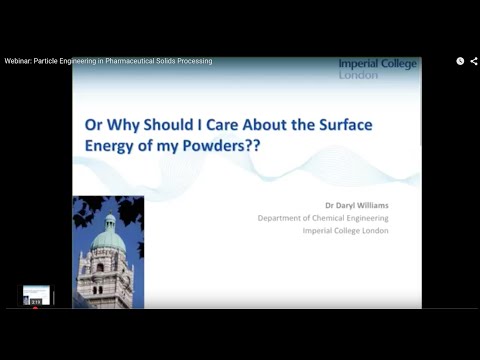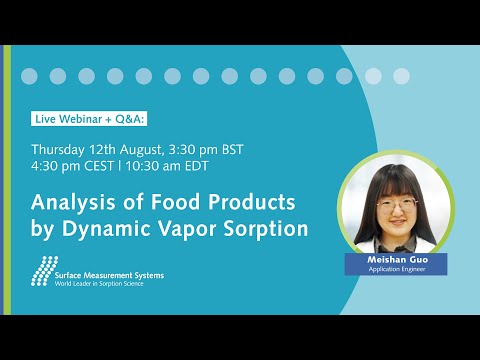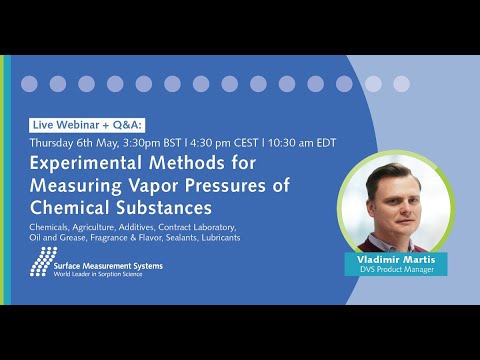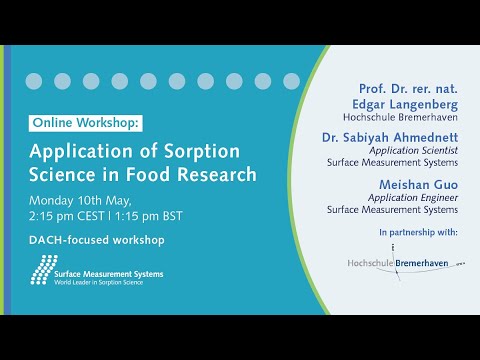
Sorption Science Webinars/Workshops Directory
To keep up to date with our upcoming events please visit: https://www.surfacemeasurementsystems.com/learning-center/webinars/
| Responsible | Daniel Villalobos |
|---|---|
| Last Update | 07/10/2025 |
| Completion Time | 1 day 4 hours 1 minute |
| Members | 249 |

Webinar title: Particle Engineering in Pharmaceutical Solids Processing: Surface Energy Considerations
Topic: This webinar presented by Dr Daryl Williams from Imperial College London reviews the surface energy and surface energy heterogeneity of crystalline solids, methods for the measurement of surface energy, effects of milling on powder surface energy, adhesion and cohesion on powder mixtures, crystal habits and surface energy, surface energy and powder granulation processes.
For more information visit our website:
www.surfacemeasurementsystems.com
LinkedIn: https://www.linkedin.com/company/surface-measurement-systems
Twitter: https://twitter.com/surfacemsystems
Food
View all
When Food & its ingredients are capable of absorbing up to 50% by mass of moisture from the air, knowing the sorption properties of your food product is essential to the R&D process. In this, Dynamic Vapor Sorption provides an unparalleled level of insight. Invented by Surface Measurement Systems’ Founder, Dr. Daryl Williams, the DVS technique enables researchers incredible levels of detail and accuracy in the physico-chemical characterization of solid-state materials.
To learn more go to: https://bit.ly/3AGzUba

Dr. Vladimir Martis, Surface Measurement Systems resident expert in Vapor Pressure, shares valuable insights and recent research findings for the Knudsen Effusion Method and Static Method for Vapor Pressure Measurement. Attendees also had a great opportunity to engage Dr. Martis directly in a live Q&A.
Vapor pressure is defined as the pressure exerted by vapor in thermodynamic equilibrium with its condensed phases (solid or liquid) at a given temperature in a closed system. It is an important physicochemical property for many applications including human health, environmental protection, vapor phase deposition processes, lubricants operational life and separation processes. In addition, the vapor pressure thermodynamic data can be used to calculate enthalpies of vaporization or sublimation. Therefore, the accurate determination of vapor pressure is fundamental for the development of models simulating the behaviour of chemicals in industrial processes or outdoor environments. There are several methods for measuring vapor pressures, as it is difficult for a single experimental method to cover entire range of vapor pressures from less than 10-15 to 105 Pa.
In this webinar, we discussed the Knudsen effusion method and static method for vapor pressure measurement. The Knudsen effusion method is used for measuring sublimation or evaporation processes below 100 Pa in the temperature range from 293 to 673K. The static method has been developed to extend the measured pressure range up to 105 Pa in the temperature range between 293 and 323K. Also, it is capable of measuring vapor pressures of liquid samples, or crystalline solids.

Accurate and detailed insight into sorption properties and surface energy is essential to sector of consumer product research; but nowhere is this more important than in the food sector. This free-to-attend online workshop explores two innovative techniques, Dynamic Vapor Sorption (DVS) and Inverse Gas Chromatography (IGC), and how they can provide unparalleled insight in the study of food.
Abstracts:
DVS and its applications in Food
The moisture sorption properties of food materials are fundamental considerations for development and enhancement of food products, since they may influence the stability and performance during processing, storage and product use. Dynamic Vapour Sorption (DVS) has long been used for investigating the interaction of water vapour with foods and food ingredients. The combination of a video microscope and vibrational spectroscopic techniques with DVS would allow for increased understanding of vapor-induced structural changes of solid materials. This workshop summarises several examples of using DVS for food-related applications including water activity, moisture content, moisture-induced phase transitions, water-vapour transmission rates, and flavour loss.
iGC and its applications in Food
The increasing sophistication of food ingredients has created the need for new techniques to measure the physico-chemical properties of a wide range of food materials. IGC – SEA is specially designed to determine the surface energy heterogeneity but nevertheless suitable for measuring different surface and bulk properties of solid materials including powder surface energies, acid/base/polar functionality of surfaces, diffusion kinetics, surface heterogeneity and phase transition temperatures/humidities.